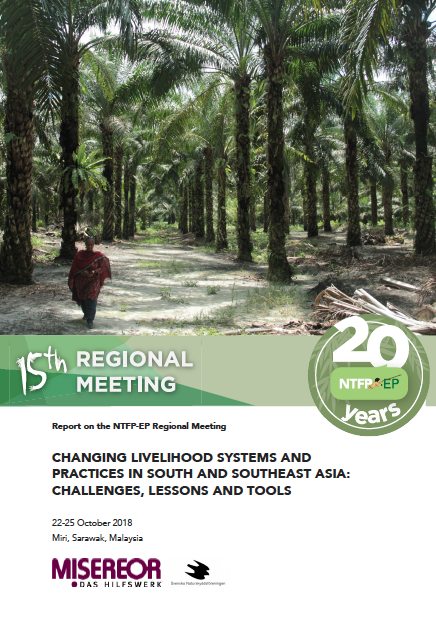
On the occasion of NTFP-EP’s 20th year anniversary in 2018, some of NTFP-EP’s founders, members, board, staff and partners across South and Southeast Asia came together to reflect upon key changes transforming the livelihood systems of traditional hunter-gatherers, indigenous and local communities dependent on forests; from nomadic/semi-nomadic to sedentary farming. Across the countries where we work in India, Indonesia, Philippines, Vietnam, Cambodia and Malaysia, along with new partners in Laos, Myanmar and Thailand, we have observed various ecological factors and economic pressures shaping this transformation. We see a decline in biodiversity and the loss of important food and economic species. Communities experience severe cultural transformation alongside examples of cultural resilience.
New research has been completed or is ongoing within the NTFP-EP network. In this regional meeting, we explored deeper conversations and analysis of NTFP-EP interventions and ways in which we are adapting our field responses. We also discussed different alternative strategies to respond to the pressures and changes to local and indigenous communities, taking into account their respective political and
economic context.
We acknowledged the various strategies being taken up within the network to respond to these changes on the ground. This regional meeting was an opportunity to also share amongst members the innovations in NTFP-EP programmes and strategies (and learn also from other participants who are new to the network) or political instruments used to affect change.
DOWNLOAD PDF

The CSO Forum has come far as a regional platform for knowledge sharing. Back in 2011, it started with we started with 10 organizations in a brown bag discussion with ASEAN Member State Representatives in Brunei. Today the CSO Forum has over 60 organizations hailing from 8 countries from ASEAN collaborating with key stakeholders towards common goals. The CSO Forum has succeeded in bringing together diverse organisations driven by the common goal of mainstreaming people-centered actions in thematic areas of social forestry and climate change adaptation and mitigation.
Over the years, the CSO Forum made significant progress in 8 countries in Southeast Asia, with particular focus on four key thematic areas. This report provides a detailed overview of the CSO Forum’s achievements in each of the thematic areas at the regional and national levels.
Thematic Reports
The past seven years have been a period of important accomplishments for the CSO Forum. Monitoring of progress for each thematic area has been guided by the following questions:
- What have been the achievements in the past 5-7 years against the CSO Forum targets?
- What has been the role and contribution of AWG-SF in these achievements?
- What has been the impact in communities?
- What do you think would be the major challenges confronting social forestry development and implementation from now until 2025?
- What are key opportunities for now until 2025?
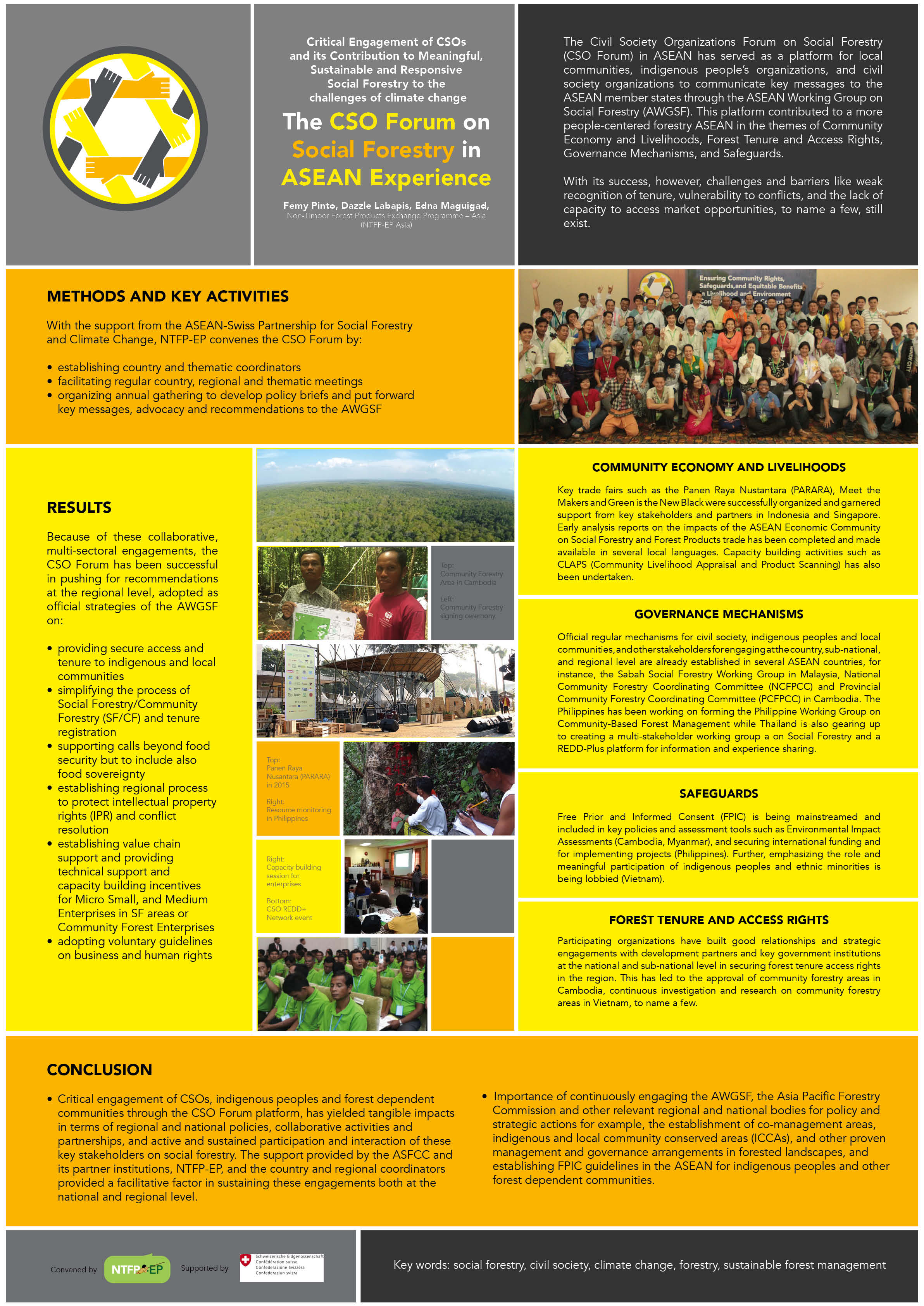
The experience of the CSO Forum in ASEAN – a platform that distills key messages from indigenous peoples and civil society organizations on social forestry and related concerns in ASEAN – finds its space in the halls of the 27th Session of the Asia-Pacific Forestry Commission (APFC) with the theme “Forestry in a new Landscape” to be held from October 23-27, 2017 in Colombo, Sri Lanka.
Indigenous and forest dependent communities continue to face challenges and barriers such as the lack of recognition of their customary tenure, their vulnerability to conflicts, and their lack of capacity to access market opportunities, to name a few.
The APFC is enjoined to take decisive positions to support indigenous and forest dependent communities in the following strategic actions:
- establishment of co-management areas, indigenous and local community conserved areas (ICCAs),
- adoption and support of other proven management and governance arrangements in forested landscapes, and the
- establishment of free, prior and informed consent (FPIC) regional guidelines (e.g. in the ASEAN) especially to safeguard indigenous and other forest dependent communities from critical and large-scale developments and projects in forested landscapes.
- support for community forest enterprises in strengthening their business capacity, working capital and market linkages.
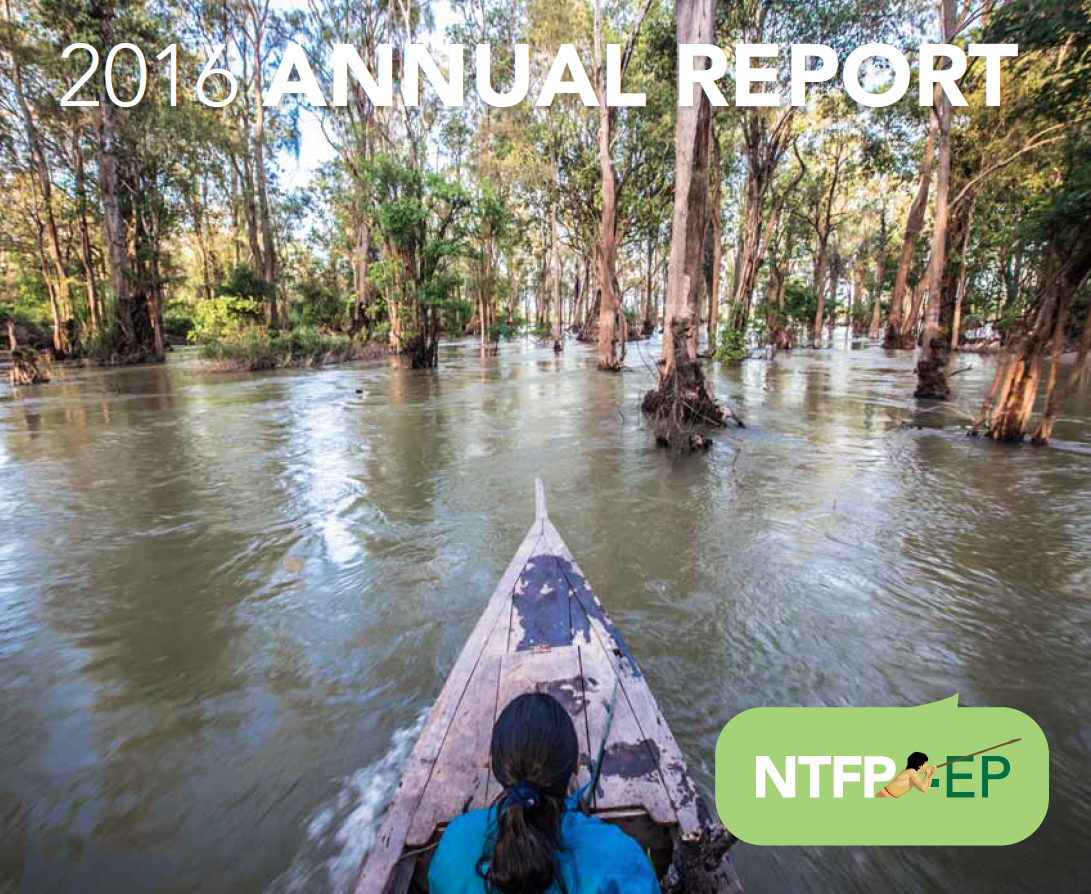
Linking People and Forests – the main thrust of NTF-PEP’s work is encapsulated in this phrase. People from the forests or those living off the forests are the vital populations for which the NTFP-EP has renewed its commitment to serve and on whom the NTFP-EP shall focus its programs from 2016-2019. The interrelatedness of the lives across generations of indigenous and local peoples to their customary lands and forests is seen in the remaining rich natural forests in our region, and cultures still steeped in a belief system of protection and care such as those of the Higaonon and Agta-Remontado of the mountain ranges of Mt. Kimangkil in Bukidnon and the Sierra Madre in the Philippines respectively, and theadivasi in India, and the Benuaq Dayak of East Kalimantan, to the Bunong of Mondulkiri and of rural Khmer in Cambodia. Conversely, it is also this interrelatedness of people and forests, that explains the severity of impact of forest loss and destruction because of extractive activities and civil conflicts like no other – from the physical and material, even more so impacts felt and seen at the social, spiritual and cultural levels of well being of forest communities.
By the close of 2016, the NTFP-EP was clear that the challenges are immense for forest peoples and for us as allies and partners in forest conservation and sustainable community development. While this is so, we saw that NTFP-EP’s role and contributions have the power to communicate and facilitate significant changes. Looking back and also looking ahead, an “exchange programme” has immense value. At the core of this is still empowerment of forest peoples, and conserved and sustained forests for future generations.

The Non-Timber Forest Products Exchange Programme (NTFP-EP) is a collaborative network of nongovernmental organizations (NGOs) and community-based organizations in South and Southeast Asia, working with forest-dependent communities to strengthen their capacity in sustainable management of these natural resources. The NTFP-EP was organized as a network to promote the use of non- timber forest products, with the fundamental purpose of protecting the forests. The forest is not just the trees but a conglomeration of many inter-dependent species of plants and animals, from the microscopic to the very large, which occupy an area together. The forest is more than the sum of its parts. There are several things that a forest accomplishes which cannot be done by anything else. They cannot even be done by the various forests species working separately. They are only done by a forest and that is why the forests must be protected (Rice, 2010).
The NTFP-EP believes that an effective way to protect and enrich the forests, and simultaneously fight poverty, is by helping forest dwellers make a good living from the forest itself by increasing the value of the various non-timber forest products (NTFPs). We define NTFPs as all biological materials from the forest that are extracted and consumed for human use (de Beer and McDermott, 1996). We believe that increasing the value of NTFPs might not be the only way to achieve the protection and enrichment of forests and at the same time to fight poverty, but it is certainly a good place to start. In brief, the NTFP-EP was founded on the goal to protect and improve the integrity of the forests and the livelihood and well-being of forest dwellers.

The Civil Society Organizations Forum on Social Forestry (CSO Forum) in ASEAN has served as a platform for local communities, indigenous people’s organizations, and civil society organizations to communicate key messages to the ASEAN member states through the ASEAN Working Group on Social Forestry (AWGSF). This platform contributed to a more people-centered forestry ASEAN in the themes of Community Economy and Livelihoods, Forest Tenure and Access Rights, Governance Mechanisms, and Safeguards since its inception in 2011.

Since its establishment in 2012, the Civil Society Organizations (CSO) Forum on Social Forestry in ASEAN has served as a platform for local communities, indigenous people’s organizations, and civil society organizations to consolidate and elevate key messages to the members of the ASEAN states through the ASEAN Working Group on Social Forestry (AWG-SF).
Today, over 50 participants representing representing 40 organizations from 8 countries in Southeast Asia are actively engaged in the forum.
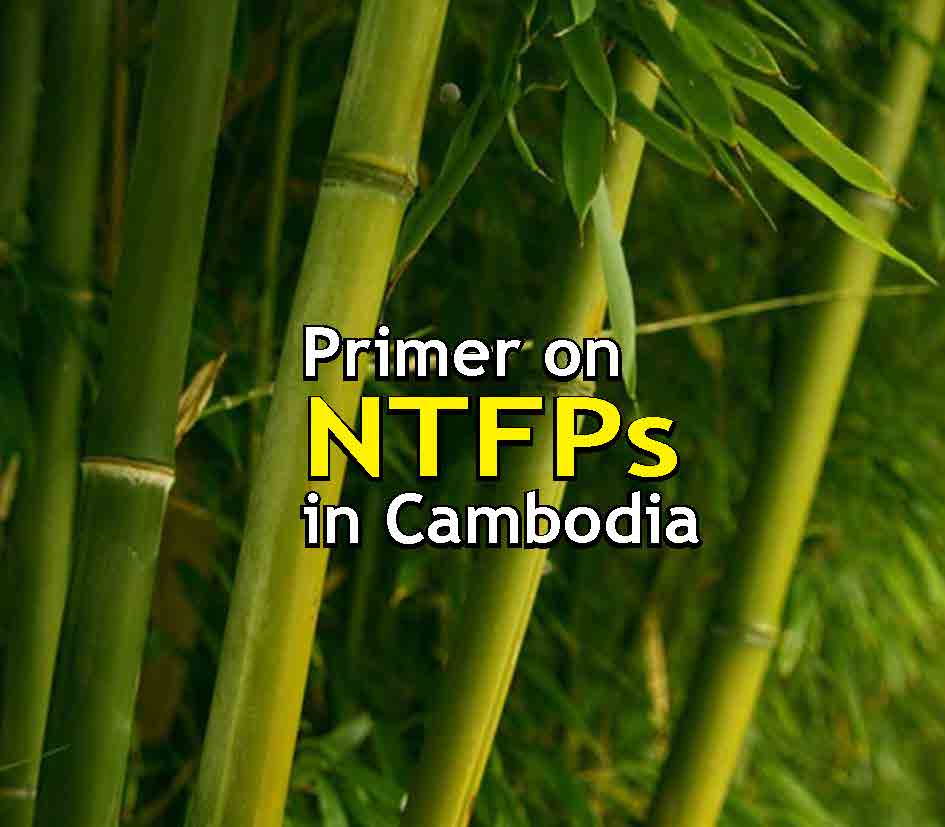
Most of the communities in Cambodia use non-timber forest products (NTFPs) as food sources (honey, mushrooms, nuts, wild fruit, edible leaves, wild potatoes, rattan and bamboo shoots), as medicines (honey and seeds) and as building materials (rattan and bamboo) or materials for creating other products (resin).
The Law on Forestry and the Law on Protected Areas in Cambodia controls the use, harvest, transport, and to some extent, the commercialization of NTFPs by local communities living near forests and protected areas. This publication is a consolidation of the existing policies and regulations relevant to the use and management of NTFPs in the country, along with issues and recommendations to address such.

Forest Harvest is a collective mark that aims to highlight the forest source and sustainability of products, starting from those coming from community partners of the Non-Timber Forest Products–Exchange Program (NTFP-EP) network. It covers all non-timber forest products that are harvested from the forests, whether from the wild or already cultivated sources.
The label guarantees that the products meet three parameters:
Traceable Forest Source
Using Participatory Guarantee Systems (PGS) or other monitoring systems in place, products or the materials used can be traced back to well-managed community forest, whether wild or cultivated in home gardens of forest-based communities.
Sustainable
The product is harvested according to the agreed sustainable harvesting protocol for the product.
Good Quality
The product is produced according to market standards and meets existing product quality standards of the market, unless a different standard is agreed upon.
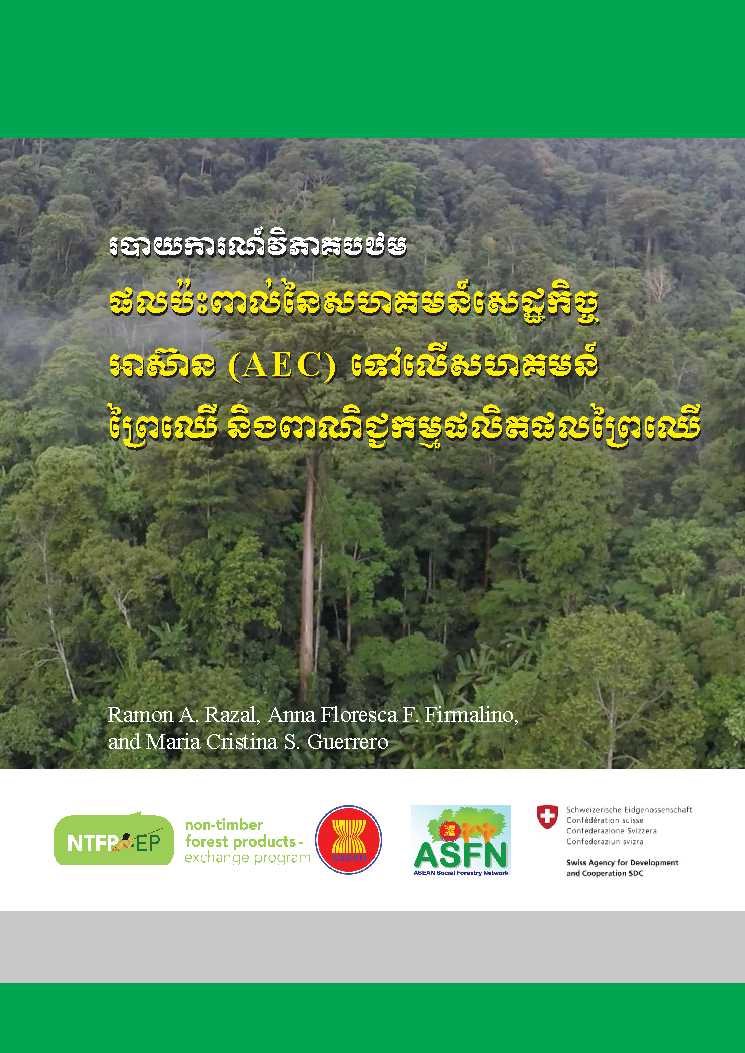
ASEAN Economic Community or AEC embodies the aspiration of regional economic integration by the 10 member states1 of the Association of Southeast Asian Nations by 31 December 2015. The AEC will have the following key characteristics: a) a single market and production base; b) a highly competitive region; c) a region of equitable economic development; and d) a region fully integrated into the global economy.
It is envisioned that the ASEAN region will become one ASEAN Community that is founded on strong economic, political, and socio-cultural partnerships among the ASEAN member states (AMS). Thus, the ASEAN Economic Community (AEC) is one the pillars of the ASEAN Community alongside the Political-Security Community (APSC) and the Socio-Cultural Community (ASCC). The economic aspects of integration will entail liberalization of trade among the AMSs including measures that will eliminate all tariffs and non-tariff barriers, enhance interconnectivity, and other measures that will allow free flow of goods, services, investment, capital and skilled labor.
The study was conducted by the Non-Timber Forest Products – Exchange Programme (NTFP-EP) with support from the ASEAN Swiss Partnership for Social Forestry and Climate Change (ASFCC). It determined the impacts (both positive and negative) of the planned economic integration on social forestry stakeholders in the ASEAN member states.










